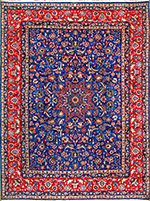Textiles Studies

Textile Research Works
Date of this Version
1990
Document Type
Article
Citation
Exhibition, The Textile Museum, Washington, DC, August 19, 1990 - February 24,1991
Abstract
A fascination with color and geometric pattern is expressed in Islamic art. In many areas of the Islamic world, historically from Spain to Indonesia, twodimensional repeat patterns provide the primary means for organizing color and space. Ornamentation of architecture, ceramics, metalwork, book illumination, textiles, and Oriental carpets relies upon the repetition of complex or simple designs, creating overall surface patterns of apparent complexity and intricacy. Patterns may consist of geometric, floral, calligraphic, or figural forms. The majority of patterns in Oriental carpets consist of geometric and stylized floral designs, arranged in a system of repeats within an oblong central field framed by borders. Traditionally, designs are arranged in the central field and borders of a single carpet according to varying systems of repeat. The profusion of patterns contributes to the sense of complexity and intricacy, which so characterizes the apparent visual aspect of Oriental carpets. Drawn from The Textile Museum's collections the carpets selected for the exhibition date from the fifteenth through the nineteenth century and reflect regional design traditions from Spain, Egypt, Turkey, Iran, and Central Asia.
Included in
Art and Materials Conservation Commons, Art Practice Commons, Fiber, Textile, and Weaving Arts Commons, Indigenous Studies Commons, Museum Studies Commons


Comments
Copyright © 1990 The Textile Museum